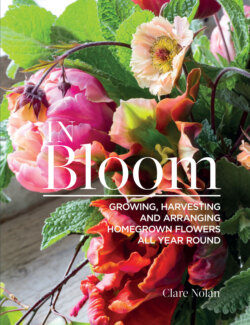Читать книгу In Bloom - Clare Nolan - Страница 21
На сайте Литреса книга снята с продажи.
PLANT SPACING
ОглавлениеWhen growing plants for cutting it’s possible to grow the plants closer together than you would normally in your main garden. I think in terms of creating blocks of plants – just as I do for vegetable growing to maximise production. For most of the annuals I grow, in a bed that’s 47 in (120cm) deep, I’ll plant out rows of 5 plants (at a spacing of roughly 9 in x 9 in [24cm x 24cm]), building up blocks of varying sizes depending on the number of plants I want. I find a block of two or three rows is normally enough for my needs as I prefer to grow small quantities of lots of different varieties. It’s a method I’ve used successfully for years and after learning more from Washington, USA-based flower grower extraordinaire, Erin Benzakein of Floret Flower Farm and her high-intensity production techniques, I’ve added a couple of her spacing regimes to mine – tweaking them slightly for a 47 in (120cm) border.
6x6 in (15x15cm) (8 plants in a row per 47 in [120cm] bed, 47x47 in [1 ⅕ x 1 ⅕m] = 64 plants)
Perfect for annuals with a more upright growth like single sunflowers or larkspur.
9x9 in (24x24cm) (5 plants in a row per 47 in [120cm] bed, 47x47 in [1 ⅕ x 1 ⅕m] =25 plants)
The spacing I use the most for annuals; cerinthe, snapdragons, Icelandic poppies all do well at this spacing.
12x12 in (30x30cm): (4 plants in a row per 47 in [120cm] bed, 47x47 in [1 ⅕ x 1 ⅕m] =16 plants)
For plants that bulk up a little more like foxgloves or branch more like Queen Anne’s lace. A good spacing for a mint bed.
16x16 in (40x40cm): (3 plants in a row per 47 in [120cm] bed, 47x47 in [1 ⅕ x 1 ⅕m] =9 plants)
For plants with large side branches, like the branching sunflowers or amaranthus.
24x24 in (60x60cm): (2 plants in a row per 47 in [120cm] bed, 47x47 in [1 ⅕ x 1 ⅕m] = 4 plants)
A general spacing suggestion for roses, but it does depend on the growth habit and variety. It’s also a good spacing for dahlias.
